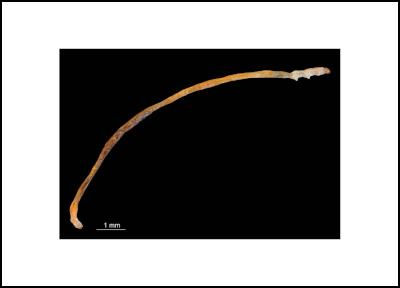Houdini-like moth gets a new name
Houdini-like moth gets a new name

Click to enlarge
"Fred the Thread" - the world's skinniest caterpillar?
Photo: Birgit E. Rhode, Landcare Research
www.landcareresearch.co.nz
Houdini-like moth gets a new name
A mystery moth that grows from what is thought to be the world’s skinniest caterpillar has received its new scientific name after confounding experts for years.
However, even now that it has come to light, its future may not be bright.
Landcare Research scientist Dr Corinne Watts first discovered a skinny, bright orange caterpillar in 2003, and nicknamed it “Fred the Thread”.
Initially, the identity of the tunnelling creature was puzzling. However, “Fred” turned out to be the caterpillar of a previously unknown genus of moth. The caterpillar lives only inside stems of the threatened rush-like plant Sporadanthus ferrugineus, which is found at just three wetland sites in Waikato.
The moth has now been named Houdinia flexilissima. Houdinia is a salute to the renowned escape artist Harry Houdini. The name was chosen because of the adult moth’s remarkable escape from the tight confines of its host plant after pupating, and because the moth escaped classification for so long. Flexilissima means “very flexible” or “pliable”.
However, it remains to be seen if the moth can pull off its most amazing escape yet – its escape from extinction. If the wetlands where Fred the Thread lives were to be drained or redeveloped, the moth would be lost forever. One of these wetlands is being mined for peat.
“We found that moving the Sporadanthus plants only 400 metres away from intact wetland habitat caused numbers of moth eggs and larvae found on the plants to plummet,” Dr Watts says.
“From an ecological standpoint it would be a real shame to lose this moth. It is highly evolved, and has an incredibly specialised relationship with its host plant.”
ENDS


 Hugh Grant: How New Tech Helps Kids Love Soccer More
Hugh Grant: How New Tech Helps Kids Love Soccer More Bill Bennett: Download Weekly - 100% claim lands One New Zealand in criminal court action
Bill Bennett: Download Weekly - 100% claim lands One New Zealand in criminal court action FSCL: Woman Scammed Out Of $25,000 After Job Offer On LinkedIn
FSCL: Woman Scammed Out Of $25,000 After Job Offer On LinkedIn NIWA: Cheers To Crustaceans - New Species Named After Welly Brewery
NIWA: Cheers To Crustaceans - New Species Named After Welly Brewery MBIE: Trans-Tasman Earth Observation Research Studies Confirmed
MBIE: Trans-Tasman Earth Observation Research Studies Confirmed NZ Association of Scientists: Royal Society Te Apārangi Governance Submissions Close - NZAS Submission
NZ Association of Scientists: Royal Society Te Apārangi Governance Submissions Close - NZAS Submission



